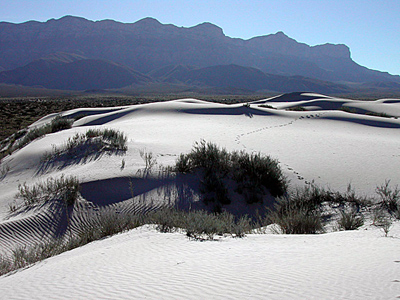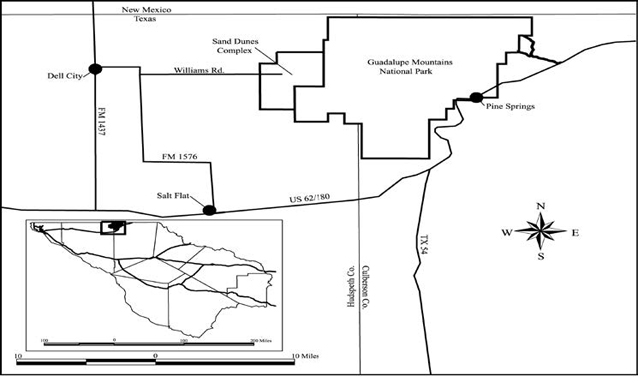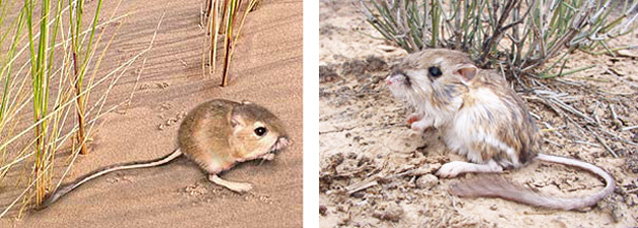Guadalupe Mountains National Park (NP) is a critical location for understanding the distribution of mammals in the Chihuahuan Desert. Situated along the Texas-New Mexico border, the park includes representative habitats from desert lowlands to mountainous highlands. Situated at the base of the western escarpment of the Guadalupe Mountains, in northern Hudspeth County, Texas, are a series of gypsum and quartz dunes of which the park acquired approximately 10,000 acres.
There have been several surveys of the mammalian fauna of the area in and around the park (1905, 1940, 1970s, 1985, and 1992), but most of these surveys concentrated on the park's mountainous regions. To date, there have been few studies that have examined the mammals of the park's lower desert regions, in particular the sand dune areas. This study began in October 2003, and ended in February 2004. The objectives of this study were (1) to determine the occurrence of mammal species in the Sand Dune Complex, (2) to estimate the relative abundance of small mammal species, and (3) to establish permanent sampling sites. The information gathered in this study is valuable as baseline data for future biodiversity studies and for detecting change over time at the park.
Methods

NPS
The sand dunes were divided into four generalized dune categories based on sand particle composition and vegetation type. Two of the dune categories were quartz-based “Red” Dunes and gypsum-based “White” Dunes. The third category was dunes designated as Intergrade Dunes (the area which separated the Red and White Dunes). Finally, the sand that surrounded both dune fields was designated as the Cover Sands. Two trap lines (transects) of 50 Sherman live traps/line, were set in each dune category for sampling small to medium-sized mammals. Pocket gophers were sampled opportunistically using McAbee gopher traps. Spotlighting at night was utilized to sample species that are difficult to sample by trapping. Large mammals were recorded by sightings or other sign. No attempts were made to capture or identify bat species. Relative abundance for small rodents was estimated based on the number of individual animals captured per unit of time and effort (i.e., trap night). Each dune category was sampled for 500 trap nights (total of 2,000 trap nights). An index of species diversity (Shannon’s Diversity Index) was estimated for each of the dune types.

Results
Thirteen mammal species were either trapped or observed by animal signs (tracks and fresh burrows): seven species of small rodents (see below), desert cottontail (Sylvilagus audubonii), black-tailed jackrabbit (Lepus californicus), yellow-faced pocket gopher (Cratogeomys castanops), coyote (Canis latrans), American badger (Taxidea taxus), and mule deer (Odocoileus hemionus). An additional ten species are known to be present in the dunes from earlier surveys and museum records.
A total of 144 captures of small rodents were recorded from the dunes. Overall, the three most common species were Merriam’s kangaroo rat (Dipodomys merriami; very abundant, 52% of all captures) Chihuahuan Desert pocket mouse (Chaetodipus eremicus; abundant, 29% of captures), and Ord’s kangaroo rat (Dipodomys ordii; common, 13% of captures). The other four small rodent species were uncommon: Merriam's pocket mouse (Perognathus meriiami), cactus mouse (Peromyscus eremicus), Mearn's grasshopper mouse (Onychomys arenicola), and Southern Plains woodrat (Neotoma micropus).
Abundance of small rodents was also examined by dune category, with the most species (n=6) trapped in the gypsum (White) dunes. The fewest species (n=3) trapped was in the Cover Sands, though this area had the highest trap success rate. The lowest trap success rate was in the Intergrade Dunes. Statistical tests within the dune categories revealed: (1) the White Dunes are significantly more diverse than either the Red Dunes or the Cover Sands; (2) the Cover Sands are also significantly less diverse than the Red Dunes; and (3) the Intergrade Dunes are not significantly different from any of the other dune categories (Red Dunes, White Dunes, Cover Sands).
Discussion

NPS
The 23 species detected in the Sand Dunes Complex of Guadalupe Mountains NP during this survey and previous surveys are comprised of of 5 carnivores, 1 artiodactyl (hooved animal like deer), 15 rodents, and 2 lagomorphs (cottontails and jackrabbits). Only three species were encountered in sufficient numbers and from several dune categories to be informative as to the abundance patterns in this area. Merriam’s kangaroo rat was the most abundant species and Chihuahuan Desert pocket mouse was second in abundance in the Cover Sands, Intergrade Dunes, and Red Dunes. The Chihuahuan Desert pocket mouse was more abundant in the Red Dunes than any other dune category. The White Dunes diverge from the pattern displayed in the other dune categories in that Ord’s kangaroo rat displaced Merriam’s kangaroo rat as the most abundant species. While three of the dune types were significantly different with respect to diversity values, Intergrade Dunes were not statistically more or less diverse than any of the other types, implying that the Intergrade Dunes are an area where species transition between the three other dune categories.
The geographic relationships of the mammals found in the Sand Dune Complex, demonstrate that this area of the park has a high affinity to the Chihuahuan Desert and the rest of the Trans-Pecos region of Texas. Fourteen species of mammals that have been recorded from the park have not been recorded in the Sand Dunes Complex. Future efforts may reveal the presence of these species in the Sand Dunes.
Originally prepared by the Chihuahuan Desert Network Inventory and Monitoring Program, 2013. Updated in 2016.
Last updated: December 4, 2016
